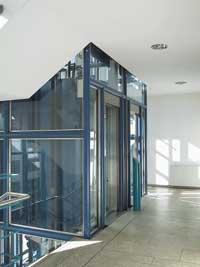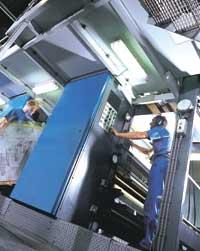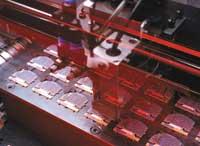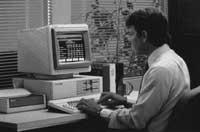Machines in networking
2001/10/01 Kortabarria Olabarria, Beñardo - Elhuyar Zientzia Iturria: Elhuyar aldizkaria
In the history of humanity, there were no machines at first. Man used his hands. Somehow, he first invented the game tools and tools, and then gradually improved them. He also invented machines, at first very simple, then more complex. Among other things, they sought that man can live more comfortably in all areas, that his work is easier and that he benefits better from it.

The machines were at a time totally mechanical. Someone was always needed around the machine: it had to be fed, cared for, stopped in case of failure and repaired. Then there was a big leap: the machines themselves came to have some autonomy, they warned against any problem, they asked for the material if necessary and they came to complete the scheduled work. This model is already dominated in many workshops and tasks, but the following steps are currently being prepared to improve communication between machines.
Communication between machines is a reality today. In many cases, machines have some intelligence, are connected to each other and have a network between them. Therefore, that is achieved. But it is more, especially with two objectives: on the one hand, being able to reach from the outside to the machines and, on the other, being able to communicate machines located in different places. At that moment the word internet appears, and that word in the business world.
The concept of the Internet can be valid for any device or machine with electronic control, washing machine, elevator, lathe... These machines have, among other things, a characteristic that equals them: they carry an electronic control that is driven with a microprocessor or a small computer. This means that these microprocessors can be tailored Internet, so from a mobile phone with any computer or Internet you can access them.

Of course, then you have to ask the question and answer the question. Will this affect machine productivity? If you look at several areas, you have to give the approval.
For example, if you look at maintenance, this type of system can mean significant savings. In fact, it offers the possibility of previous and remote maintenance. With an example you can better understand the situation, for example with elevator maintenance. The company that has hundreds of lifts installed is legally obliged to track them to ensure at all times their good condition. Currently, maintenance workers, according to a certain frequency, have to visit each of the lifts. The installation of the Internet in the elevators would allow the company to control the elevators from some point of the same, not only that, but also through laptops, such as mobile phones with WAP, access and control of the facilities.
Of course, if you have to replace some piece, in the end someone will have to go to the place where the elevator is, but you will have much more advanced: you will know exactly the piece to replace, the history of the elevator, the problems you have…
Beyond maintenance, telecommunications can play an important role in machine tuning tasks. This, for example, is evident when buying a new appliance. The seller can explain to the buyer online how to start the new appliance, how to use it, how to solve the small problems that may arise, etc.
In companies the situation is very similar. Until new machines are purchased and started, there is a process to complete. In most of these cases it is necessary to carry out advisory work, training process of the operators who will work with the machine and, in many cases, adapt the machine itself to the specific production process. At present, this whole process is complemented by the incorporation of an expert sent by the seller, especially when the machines – strawberries, lathes… – are of great value and enter into complex production processes. The cost of holding a person or group in these works is high and can be avoided if there is the possibility of remote computer consulting.
Internet in machines

To be able to communicate with machines can be enough with a PC and a modem, since no special application is required. Connections can currently be made via GSM, can be made shortly via GPRS and is expected to be made in a few years via UMTS. Connections through classic telephony, via cable, are also there, and later fiber optic can be used. Therefore, the connection paths can be many, but at the base is the same idea of making economic connections between machines and machines using current technology, that is, connections through the Internet with local call cost.
However, the Internet and conventional machines are not usually the same, they may be but they are not. Today, personal computers are machines of a certain capacity, capable of processing and storing many data quickly. The market is also wide and many products are manufactured according to these characteristics of PCs. In the case of electronic controls of the machines everything is observed. Both machining and numerical machine tools, for example, having to use a lot of data, most come from the PC. But if the machines are smaller, the complexity of the electronic components they contain is much less. Logically, in these cases, in the absence of being able to use products developed specifically for PCs, it is necessary to make custom components, including tailored Internet.

In Euskal Herria several works of this type are being carried out. In Ikerlan, for example, one of the tasks is that. “We use the existing microprocessors on the market and develop the applications that will work within this microprocessor to make the Internet connection. The greater the number of applications, this microprocessor will be closer to the usual PCs and therefore the Internet that will be put on the machine will be closer to the traditional Internet network. When fewer apps are needed, we reduce the Internet and the services that can be offered through it.” It is therefore about tailor-made developments and bespoke products, although with standards that meet all Internet standards but do not offer all services. It depends on the customer.

Gai honi buruzko eduki gehiago
Elhuyarrek garatutako teknologia





